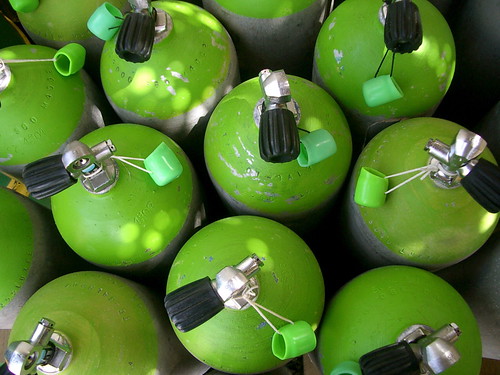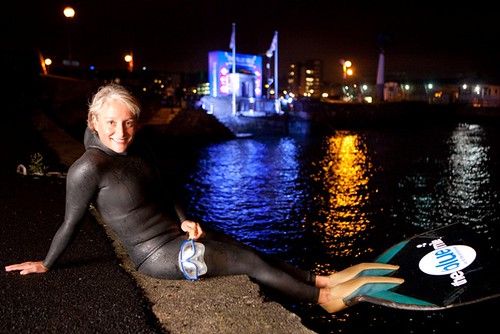Because I'm a freediver. I use mask, fin and wet-suit when I want to dive. Freedivers said! Freediving is any of various aquatic activities that share the practice of breath-hold underwater diving. The activity that garners the most public attention is competitive apnea, an extreme sport, in which competitors attempt to attain great depths, times or distances on a single breath without direct assistance of scuba.
Photo: Iner
Freediving is the sport of breath hold diving in which the freediver descends under water on a single breath of air. Freediving includes leisure activities such as spearfishing and snorkelling as well as competitive disciplines: Constant Weight, Free Immersion, Variable Weight, No Limits, Dynamic and Static Apnea. Freediving is a technique used with various aquatic activities. While in general all aquatic activities that include breath-hold diving might be classified as a part of freediving, some sports are more accepted than others.
Freediving has many benefits and can be compared to a martial art. It promotes increased lung capacity, deeper levels of awareness and perception and control over your body. The discussion remains whether freediving is only a synonym for breath-hold diving or whether it describes a specific group of underwater activities. It is often strongly associated with competitive breath-hold diving or Competitive Apnea. The remainder of this article will discuss only competitive freediving as an athletic sport. Freediving is also an intriguing recreational sport, celebrated as a relaxing, liberating, and unique experience.
World Champion Freediver
In October 2007 Sara Campbell became the first woman to hit the 90m mark in freediving using only the natural propulsion of her monofin. She also scored a hat trick by setting three world records in three days, in fact in under 48 hours, ruling in all deep disciplines. And just ten days later she became World Champion in Constant Weight. Amazingly she had made her first competitive dive only seven months previously. In April 2nd 2009. Sara Campbell breaks a new woman freediving World Record in the Bahamas by diving to 96m in constant weight.
Photo: The Blue Mile Gallery
Get Start Freediving
While others may dive deeper and longer, a 45-second dive to 30 feet places you in the action. Since most of the ocean's color and animal life resides within 30 feet of the surface, there's little reason to go deeper. Forty-five seconds buys you enough time to gather game, take a photo or simply mingle as one with the fish.
Best of all, the average person can master these dives in just two weeks without spending valuable travel dollars on gear. Your essentials mask, snorkel, fins, wetsuit and weight belt-pack easily into a duffle bag. They're inexpensive yet eloquent enhancements to any aquatic vacation. You needn't be an athlete to enjoy freediving because the sport is more about mind-set, technique and correct weighting than strength.
Your goal is to join the water, rolling with the gentle sea surface, never fighting it. When you learn the basic surface dive, you'll find that it takes very little energy to slip below the surface. Relaxed and confident, you choose the depth and duration of each dive. How should you learn freediving? Not like the newlyweds I observed in Hawaii. Offering verbal support, the young man coaxed his lady into the water. Timidly she placed the unfamiliar snorkel into her mouth, flip-flopped to the reef's edge and jumped in.
Photo: e m m a
So, Freediving is about familiarity, ease, relaxation and energy conservation. To learn to freedive, find a competent, patient instructor who will guide you through the selection of your gear and who can introduce you to the basic elements of the sport in a step-wise, confidence-building fashion.
Just avoid advancing one step until you're competent with the last. Choose a comfortable mask and fins, sit by the pool's edge and become familiar with mouth-breathing through the snorkel. Step into the pool waist deep, dip your head underwater and continue breathing. Freedivers utilize two positions, horizontal and inverted, positions not usually associated with sporting activities. Advance to the horizontal by holding the pool's edge and floating face down. Breathe slowly and a little deeper to compensate for the useless "dead-space air" in your snorkel. Take a deep breath, completely submerge your head and let the snorkel fill with water. Still looking down, raise your head level with the surface and again clear the snorkel. Later, you'll learn to let a small amount of air escape into your snorkel as you ascend from a dive.
Now you're ready for the most important exercise in freediving: the "relaxed fetal position." The feelings and sensations you derive from this exercise provide your psychological base. It's the state of mind you need to recall and maintain throughout your freediving career. Breathing on the surface, simply float on your stomach, curl up into the fetal position and totally relax. Some divers come close to sleep.
Photo: mst7022
Freedivers use three fin strokes: the flutter, frog and dolphin. You'll use the flutter kick most of the time. Use the frog kick, the slower of the three, to relieve cramped and tired flutter-kick muscles. The dolphin kick is great for short bursts of speed. Make sure you use short kicks and not deep leg kicks that bend the blade more than 30 degrees. When your stroke bends the blade excessively, water spills off the side and wastes energy. Take a cue from the fish to pick up speed, use rapid small fin beats, not wide movements. The surface dive is a complex yet easily mastered maneuver. It's basic to the sport.
To get an idea of how the surface dive works, lie on your bed, belly down. Scoot over the edge until you're balanced at the waist. Now, lower one arm and raise the opposite leg. The weight shift sends you immediately down. In the water, initiate the dive by kicking forward to gain momentum. Fold your shoulders together to help you exhale deeply and spread them for a maximal inhalation.
To understand the importance of streamlining, try this test. Take a yard stick and plunge it into the water at an angle with the surface. Note the resistance. Now, place the ruler on its edge and feel how easily it slips into the water.
Sources: wikipedia.org/, britishfreediving.org/, freedive.net/, sarafreediver.com/
Friday, August 7, 2009
No Tank - No Thanks, I Do Not Need A Scuba Tank.
Labels: flip-flopped, Freediver, Freediving, surface dive
Posted by ThanateTan at 9:50 PM
Subscribe to:
Post Comments (Atom)


1 comments:
I love these shots- even though they are ordinary things, the angles and colours are great.
Haven't taken to a diving suit in years- one of these days...
Post a Comment